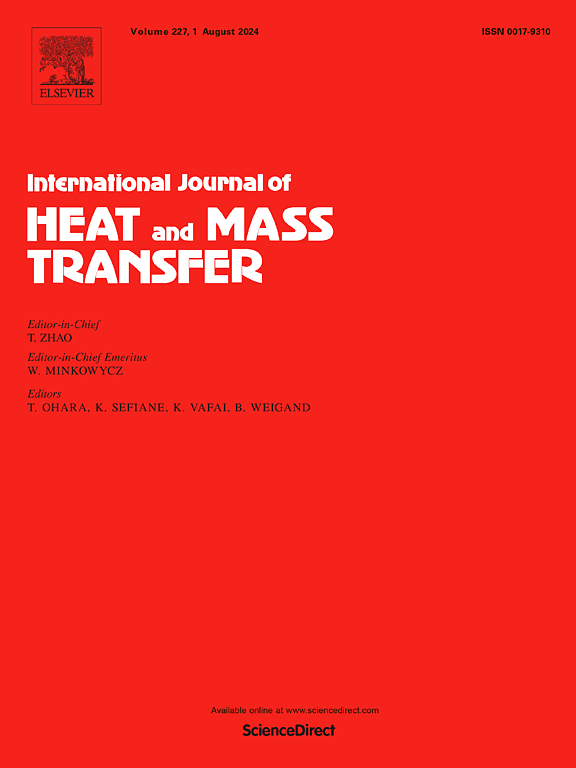Coupled processes of tissue oxygenation and fluid flow in biphasic vocal folds
IF 5
2区 工程技术
Q1 ENGINEERING, MECHANICAL
International Journal of Heat and Mass Transfer
Pub Date : 2024-11-28
DOI:10.1016/j.ijheatmasstransfer.2024.126494
引用次数: 0
Abstract
Fluid-structure interaction (FSI) between the glottal airflow and the poroelastic tissue of the vocal folds (VFs) causes the VFs to vibrate, resulting in voice production. Prior experimental studies have reported that biological transport processes within the VF tissue play a crucial role in disease initiation and localized lesions. Particularly, it has been observed that physiological conditions during phonation influence the interstitial flow within the tissue and the associated oxygen partial pressure, which corresponds with dysfunctions such as intermittent hypoxia. The goal of this research is to develop a multiphysics computational methodology that investigates oxygen transport characteristics within the VFs. By considering transient glottal airflow and a biphasic description for the tissue, this coupled framework combines an FSI model with a mass transport model to quantify key features contributing to VF oxygenation. The Navier-Stokes equations represent the aerodynamics in the larynx, while linear elasticity for tissue dynamics is considered. Additionally, oxygen transport is simulated using the advection-diffusion-reaction equation, and the interstitial flow is solved via the Brinkman equation. Physiological parameters such as oxygen metabolic consumption, subglottal lung pressure, and tissue permeability coefficient are varied; and their contribution to oxygen supply as well as to the liquid dynamics within the VF are quantified. It is found that filtration velocity is directly proportional to subglottal pressure and tissue permeability. Oxygen flow is also found to be inversely related to reaction rate, directly related to permeability, and not noticeably affected by subglottal pressure. The findings provide insight into the VF oxygenation pathways and the potential link with some pathological states such as hypoxia and localized lesions.
双相声带组织氧合和流体流动的耦合过程
声门气流与声带的孔隙弹性组织之间的流固相互作用(FSI)导致声带振动,从而产生声音。先前的实验研究报道,VF组织内的生物运输过程在疾病的发生和局部病变中起着至关重要的作用。特别是,已经观察到发声过程中的生理条件会影响组织内的间质流动和相关的氧分压,这与间歇性缺氧等功能障碍相对应。本研究的目标是开发一种多物理场计算方法来研究VFs内氧输运特性。通过考虑瞬时声门气流和组织的双相描述,该耦合框架将FSI模型与质量传递模型相结合,以量化有助于VF氧合的关键特征。Navier-Stokes方程代表喉部的空气动力学,而组织动力学则考虑线性弹性。此外,氧输运采用平流-扩散-反应方程模拟,间隙流动采用Brinkman方程求解。生理参数如氧代谢消耗、声门下肺压力、组织渗透系数等变化;以及它们对供氧和VF内液体动力学的贡献进行了量化。发现滤过速度与声门下压力和组织渗透性成正比。氧流量也被发现与反应速率成反比,与渗透性直接相关,并且不明显受到声门下压力的影响。这些发现为VF氧合途径以及与一些病理状态(如缺氧和局部病变)的潜在联系提供了见解。
本文章由计算机程序翻译,如有差异,请以英文原文为准。
求助全文
约1分钟内获得全文
求助全文
来源期刊
CiteScore
10.30
自引率
13.50%
发文量
1319
审稿时长
41 days
期刊介绍:
International Journal of Heat and Mass Transfer is the vehicle for the exchange of basic ideas in heat and mass transfer between research workers and engineers throughout the world. It focuses on both analytical and experimental research, with an emphasis on contributions which increase the basic understanding of transfer processes and their application to engineering problems.
Topics include:
-New methods of measuring and/or correlating transport-property data
-Energy engineering
-Environmental applications of heat and/or mass transfer

 求助内容:
求助内容: 应助结果提醒方式:
应助结果提醒方式:


